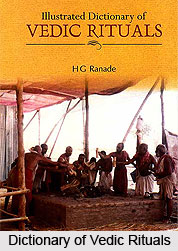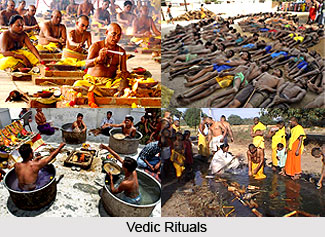 The rituals and beliefs that are followed in the present day Hinduism can all be attributed to the Vedic Rituals and practices. Soma was a sacred god in the Vedas. The same entity was referred as the god, the drink, and the plant. Vedic religion had a vast array of religious rites being performed to the different deities. Yajna is a Vedic sacrifice which is complete with an inner and an outer aspect. The Vedic priests considered `yajnas` as the means to invoke gods and seek their blessings and favours. Many purposes were associated with the performance of these Yajnas, and at various intervals of the year they were performed.
The rituals and beliefs that are followed in the present day Hinduism can all be attributed to the Vedic Rituals and practices. Soma was a sacred god in the Vedas. The same entity was referred as the god, the drink, and the plant. Vedic religion had a vast array of religious rites being performed to the different deities. Yajna is a Vedic sacrifice which is complete with an inner and an outer aspect. The Vedic priests considered `yajnas` as the means to invoke gods and seek their blessings and favours. Many purposes were associated with the performance of these Yajnas, and at various intervals of the year they were performed.
During the time of harvest, sowing period, initiation of some social event or even while going for wars yajnas were organised. A very popular Yajna during those days was the Ashwamedha Yajna or the horse sacrifice, being performed by powerful kings. This was done to prove their valour and the extent of their kingdom and influence. Yajnas basically constitute building an alter, kindling fire in that and then pouring oblations such as ghee, butter, grains etc. All these are accompanied by the chanting of sacred verses from the Vedas like the Gayatri Mantra.
There are thousands of Vedic hymns contained in the religious scriptures. Some of the Vedic hymns, especially the ones in the Rig Veda are considered to be very old at least 6000 to 8000 years old. The Rig Veda, the Yajur Veda and the Sama Veda were the group of Vedas known as the `trayi Vidya` having three-fold knowledge. The last one that is the Atharva Veda was added later on. The Atharva Veda is an absolute mine of information about the popular beliefs of the people not sophisticated by the influence of the Brahmanical class. Agnihotra is a Vedic yajna where the performers purify themselves with water, and then the usual yajna rites follow.
 The offering in this yajna is to the fire at the time of sunrise and sunset accompanied by chanting of verses. Agnicayana was the ritual of piling the fire alter, practiced until the late Vedic period, taking 12 days to perform in the process of which a bird shaped alter is built. This ritual is a Srauta ritual of the Vedic religion. Agnistoma also known as the fire sacrifice is one of the seven Soma yajnas. Other rituals are included in the Atharva Veda, which are basically concerned with medicine and healing practices.
The offering in this yajna is to the fire at the time of sunrise and sunset accompanied by chanting of verses. Agnicayana was the ritual of piling the fire alter, practiced until the late Vedic period, taking 12 days to perform in the process of which a bird shaped alter is built. This ritual is a Srauta ritual of the Vedic religion. Agnistoma also known as the fire sacrifice is one of the seven Soma yajnas. Other rituals are included in the Atharva Veda, which are basically concerned with medicine and healing practices.
People in the Vedic period appear to have believed in the survival of the spirits of forests, trees and plants. Bad dreams were looked upon with great fear and demons were believed to obstruct the flow of rivers, rainfall and to cause darkness, drought, etc. and to persuade people to use harsh words. Natural phenomena were personified and divinity was imposed on them. Gods can be classified as terrestrial gods and heavenly gods. With the passage of time, the Rig Vedic gods went through a phase of transformation and change in the Atharva Veda. The gods of the Rig Veda were essentially natural phenomenon, but the Aryans tried to personify them and thus the anthropomorphism began. There are actually two major families of gods, the Devas and the Asuras. The agricultural implements were regarded as gods in the Vedic age. Rivers are considered as deified goddesses most important being the Sapta Sindhu and the Sarasvati river. Lord Yama is also worshipped as deity though he is the god of the underworld and death.
People believed in miracles caused through heavenly favour. The ideas of the Vedic people about gods and their activities also included some folk elements. While some gods are supposed to have human forms, others are conceived as possessed of the appearances of certain beasts and birds. Several omens and portents are stated in the Rig Veda. The Atharva Veda reflects popular beliefs and practices in a far larger measure than any other Vedic Samhitas. Further, according to Atharva Veda priests were believed to possess supernatural power. They were regarded as controlling adverse forces, by magical means.



















